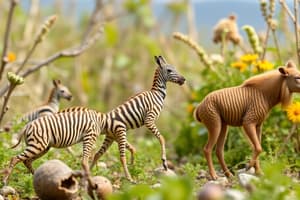Podcast
Questions and Answers
What is the correct interpretation of the statement 'organisms evolve in response to a change in an environment'?
What is the correct interpretation of the statement 'organisms evolve in response to a change in an environment'?
- A population evolves in response to a changing environment. (correct)
- Individual organisms evolve in response to environmental changes.
- Environmental changes cause mutations in individual organisms.
- Evolution is a goal-directed process that aims to create better organisms.
What happens to the individuals in a population that have particular phenotypes that benefit from a changed environment?
What happens to the individuals in a population that have particular phenotypes that benefit from a changed environment?
- They remain unaffected by the environmental change.
- They produce proportionately more offspring than other phenotypes. (correct)
- They start to mutate to become more resistant.
- They are more likely to die out.
What is the source of the variation that natural selection works on?
What is the source of the variation that natural selection works on?
- Genetic drift caused by environmental changes.
- Gene flow from other populations.
- Variation that is already present in the population. (correct)
- Mutations that arise in response to environmental changes.
What is the result of applying antibiotics to a population of bacteria?
What is the result of applying antibiotics to a population of bacteria?
What is the ultimate goal of evolution?
What is the ultimate goal of evolution?
What is the primary characteristic that defines the hominin group?
What is the primary characteristic that defines the hominin group?
What is the estimated time range for the divergence between human and chimpanzee lineages?
What is the estimated time range for the divergence between human and chimpanzee lineages?
What is the significance of the wide range of estimates for the divergence between human and ape lineages?
What is the significance of the wide range of estimates for the divergence between human and ape lineages?
What is the implication of considering taxonomy as a hypothesis?
What is the implication of considering taxonomy as a hypothesis?
What is the term that refers to all humans and our extinct bipedal ancestors and relatives since our divergence from the last common ancestor with chimpanzees?
What is the term that refers to all humans and our extinct bipedal ancestors and relatives since our divergence from the last common ancestor with chimpanzees?
Flashcards are hidden until you start studying
Study Notes
Evolutionary Misconceptions
- Statements about organisms evolving in response to environmental changes can lead to misunderstandings, primarily because individual organisms do not evolve; instead, populations evolve in response to changing environments.
Natural Selection and Variation
- A changed environment benefits individuals with particular phenotypes, leading to proportionately more offspring and resulting in a change in the population, if the characteristics are genetically determined.
- The variation that natural selection works on is already present in a population and does not arise in response to an environmental change.
Antibiotic Resistance Example
- Applying antibiotics to a population of bacteria selects a population of bacteria that are resistant to antibiotics due to a pre-existing gene.
- The antibiotic does not cause a mutation for antibiotic resistance; instead, it kills non-resistant bacteria, allowing the resistant ones to survive and reproduce.
Evolution is Not Goal-Directed
- Evolution is not directed towards making species "better" over time; instead, species adapt to their changing environment to maximize their reproduction.
- What characteristics evolve in a species are a function of the variation present and the environment, both of which are constantly changing in a non-directional way.
Fitness and Adaptation
- A trait that is fit in one environment at one time may become fatal at some point in the future, regardless of the species.
- Fitness and adaptation are relative to the specific environment and time, and do not imply a linear progression towards "better" species.
Understanding Hominins
- Studying hominin ancestors and relatives exposes us to alternative evolutionary paths and different ways of being human.
- The term "hominin" is defined by bipedalism, which is the habitual walking upright on two feet.
- Hominins include humans and all extinct bipedal ancestors and relatives since the divergence from the last common ancestor with chimpanzees.
Timeline of Human-Chimpanzee Divergence
- Many scientists believe that the human-chimpanzee lineage split occurred around 6 million years ago.
- DNA analysis using estimated mutation rates suggests that the split may have occurred earlier, between 7-8 million years ago or as far back as 13 million years ago.
- The divergence between human and gorilla lines may have occurred as far back as 8-19 million years ago.
Importance of Taxonomy
- Taxonomy is a hypothesis, not a fixed truth, and is subject to change as new discoveries and methods arise.
- This uncertainty is exemplified by the wide range of estimates for the human-chimpanzee divergence.
Studying That Suits You
Use AI to generate personalized quizzes and flashcards to suit your learning preferences.



